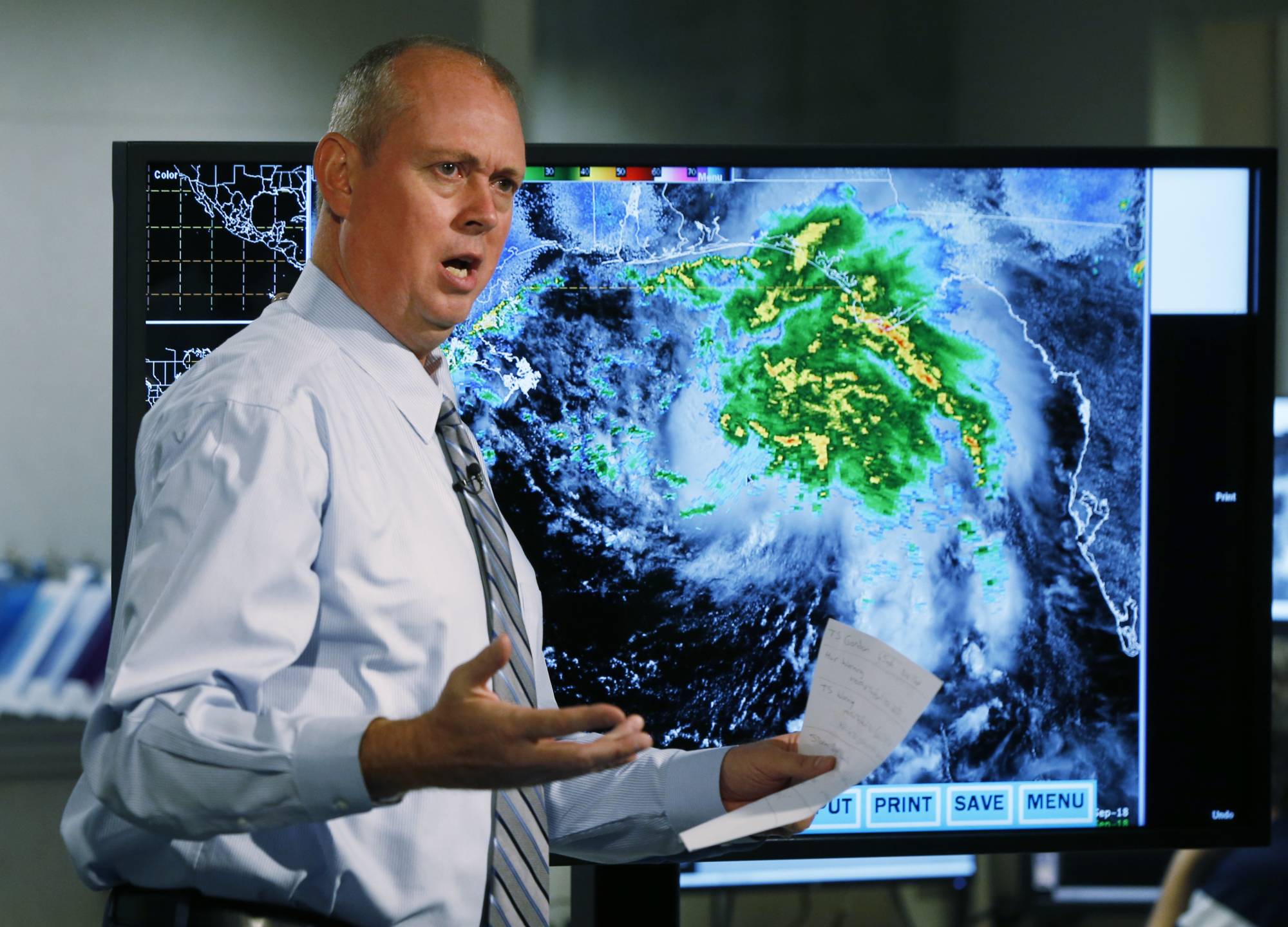Artificial intelligence is starting to help federal weather forecasting
Few endeavors have engaged the world's best minds than predicting the weather. Forecasting has improved since the days of sailing ships. Now artificial intelligence...
Few endeavors have engaged the world’s best minds than predicting the weather. Forecasting has improved since the days of sailing ships. Now artificial intelligence is blowing in like a Category 5 hurricane. To get more on what the forecast is, on the horizon, the Federal Drive with Tom Temin spoke with someone who thinks AI will reshape weather forecasting: Amy McGovern is head of the National Science Foundation AI Institute for Research in the field of weather and climate.
Interview Transcript:
Tom Temin So you have written extensively then on this topic of AI. It seems logical for AI to augment forecasting. But let me ask you this. What can I bring to it that all of the supercomputing available to the Energy Department, to the Commerce Department, that they bring to bear now the quadrillions of cycles a week that they run. What can AI do to enhance weather forecasting at this point?
Amy McGovern There’s lots left to do. Weather forecasting is not a solved topic, as you probably know, but I wouldn’t say that you know your question asking what can we do that supercomputing can’t? AI is using a lot of that supercomputing power. So, the current weather forecasting models are what they call numerical weather prediction. It’s basically simulations of the laws of physics. And they break the atmosphere up into cubes and they simulate each cube. And they’re doing that inside the supercomputer and simulating how the cubes interact with each other. And the laws of physics are difficult to represent. Everything that’s happening at every single level and every single scale, like the giant scales of the huge storms or system, like the Jetstream that’s moving across at a much larger scale, and then all the way down to something like a tornado that’s really, really small. So those models are never going to get everything completely correct. And AI is helping to do a lot of that. So, there’s a variety of AI applications. One of them is that they’re just completely replacing those models with AI. Others are that they’re taking pieces of those and replacing some of those laws of physics and the simulations and the approximations that they’re doing to a lot of physics with AI. And that can be faster. That’s one of the big benefits, is that it can be much, much faster than what’s going on right now in those computers. So, imagine you don’t know exactly what’s going to happen. So, you have some uncertainty, and you want to say, you know, do a couple of ensembles. Right now, those numerical weather prediction models are extremely expensive to do an ensemble. Once you’ve trained an AI model, you can do an ensemble very, very cheaply. So, you could, in just a few seconds get a thousand ensembles.
Tom Temin By the way, is this being tried by NOAA and the National Weather Service and so on?
Amy McGovern NOAA is certainly actively jumping into the AI space. Those global weather models that I was talking about are primarily being developed by private industry right now. Inside, at least in the US, outside the U.S., there’s some government agencies that are being involved, but NOAA is jumping into that space.
Tom Temin So in many ways, then this is a way to predict chaos. And chaos is not really chaos. It’s just that we don’t know all the variables that make up to what looks like chaos. That a fair way to put it.
Amy McGovern I would agree with that, but I don’t think that we’re going to be solving it anytime soon yet either. Right? We’re going to be improving our prediction of that chaos, but there’s still going to be parts of it that we don’t know how to do yet.
Tom Temin Because the weather people say we’re really good at the next 12 hours, we’re darn good at the next 24 hours. The further out you get, then you’re into the Farmer’s Almanac territory, which is, you know, a guess and a wet finger in the wind.
Amy McGovern Well, they can do better than Farmer’s Almanac, but Farmer’s Almanac is primarily a climatology also. Right. So, keep in mind that that’s what as you get farther and farther out, climatology becomes really the better answer. It is harder. The chaos really does add up over time. Sure. But you know, yeah, the AI models, are we already doing really, really well at the at the near term like you brought up. But the AI models can help us improve that long term forecast. The other thing AI models can do, I mentioned that that the computation right now is really, really slow, but that’s just because the way that it works, the laws of physics and everything on those parallel supercomputers are just not super-fast. Imagine you’re ingesting data in order to make your model run as quickly as possible, with as recent of data as you can. It takes about on today’s supercomputer, takes about a half an hour to give you the next forecast for the next two hours. I could take that gap, and we have some work that shows that that you could then, in real time, ingest the real time data and give you an improved forecast over that next half hour while the model is still running.
Tom Temin We’re speaking with Amy McGovern. She’s leader of the National Science Foundation’s Institute for Research on Trustworthy AI, weather, climate and coastal oceanography. That takes in a lot in the short run that your unit covers.
Amy McGovern But has a short name. If you want to look us up on a website. By the way, AI2ES.org, two being a number.
Tom Temin Yeah, I’ve been there. It’s pretty interesting. And we’ll have that link at the bottom of the interview when we post this online. But I wanted to ask then it seems like you’re saying that AI can help in two ways. One, actually make better forecasts further out than are possible now, and also maybe to do it cheaper just by condensing computing requirements.
Amy McGovern Yes, it can do it cheaper and faster. I would say that the training is still a lot of computation, but once you’ve got the trained model, it’s much cheaper, much faster to be able to do those forecasts.
Tom Temin Because faster in some ways is better because you can do things sooner. But with conventional techniques, even if you could run them faster, they wouldn’t be any more accurate as you get further and further out.
Amy McGovern Correct and also faster with the current computational limitations, it’s you’re running into a limit the way that it’s. Structured in the way that the parallelization is done. You can’t really make it a whole lot faster right now. They’re pretty much up against the limits of the machine.
Tom Temin Got it. So, what does it take, then, for an organization to bring these kinds of algorithms into their workflows and to really make this part of their operations?
Amy McGovern They want to work with AI researchers. So, we have a convergent team, and I’m using that word specifically. Convergent means that you’re working across disciplines and you’re working deeply on an interesting problem across those disciplines that all disciplines care about. This is a definition from NSF. And we have a team that is AI scientists working with atmospheric and ocean scientists and also working with social scientists. Right. And so, my answer to your question is it really takes an interdisciplinary team working together to identify the problem, really understand the needs of your end users, which is what we’re doing, and then develop a solution for those end users and then make sure that it’s working. That’s why it takes all of those members of the team so that they understand the needs. They make sure that’s working that part about being trustworthy. We’re really trying to make sure that not only we’re developing trustworthy AI, but we understand what it means to be trustworthy.
Tom Temin Right? And one of the elements of trustworthiness is making sure that you use the best and most appropriate data for training, whatever the application is you’re doing. Is the danger of drift or hallucinations, whatever they call it, increasingly worse outcomes. Is that possible when you say, like NOAA is using weather data over and over again, that is to say you’re using data from a very narrow domain and within a well-known set of principles. It seems like a pretty safe way to train your AI.
Amy McGovern That’s an interesting question. One of the things we’re doing in our NAI2S is working on the development of responsible and ethical AI for weather. And initially people thought, well, you know, these issues about ethical I don’t apply to weather for exactly the reason that you’re talking about. Right. The weather sensors are objective and they’re just giving us information that’s objective. There’s no bias to that information. But we’ve demonstrated that there’s a variety of ways in which I could go really wrong. And I think that’s what you’re asking about. I mean, you were asking specifically about drift. You could get this drift from having uncertainty in your initial data. I mean, nothing’s actually perfect, but you can also make your AI go very, very wrong if there’s just bias in your underlying training data and you don’t know about that, if you’re not correcting for that bias, you could be just amplifying it over time. And that could also be a significant problem.
Tom Temin Yeah. What’s the type of bias that could be in weather data say it’s gathered too much from the Atlantic and not enough from the Pacific, or this atmospheric height instead of that atmospheric height.
Amy McGovern Similar to that. I mean, there’s laws of physics bias that, you know, something that you can’t really get around. So, you know, the satellite can only observe data as they go around and orbit things. So, they can only give you so much data at certain intervals. There’s also just a lack of data for the global South. The global north is pretty well instrumented. The United States if you if you were to I know you’re doing this as a voice podcast but imagine a map of all the instruments that are measuring everything. The United States is really well instrumented. Most of Europe is really well instrumented. Most of the rest of the world is not as well instrumented. Plus, if you just want to look at the ocean, the oceans missing an awful lot of sensors, and that could be causing a lot of bias because you’re making estimates of what’s going on there, but you’re not necessarily knowing what’s going on.
Tom Temin And yet there’s the sense that the ocean is really the source of all of the weather stuff that happens in the first place.
Amy McGovern Yes, the ocean really needs a lot better sensing network.
Tom Temin Got it.
Amy McGovern But, you know, this is not exactly a cheap solution, right? I can’t just toss $1 million at it and go here, go fix the ocean.
Tom Temin No, maybe the CubeSat fleet that could be launched cheaper and cheaper all the time. Could maybe cover the oceans with satellite data gathering. That’s not there now.
Amy McGovern There are a couple of companies that are working on exactly that.
Tom Temin And by the way, what is the nature of the AI that is being used in weather? Is it a traditional algorithm that people have understood for a while? Is it the large language model style or what is it?
Amy McGovern That’s an excellent question. It’s a mixture of all of them. So, there’s certainly pieces that are traditional AI. That’s what I would call them, that are methods that have been around a very long time. But a lot of the more recent work is in deep learning, which is what you’re talking about. So deep learning and then getting us into the generative AI models, the large language style, those are foundational in generative AI models. That’s more of where those global weather models that I was talking about are going. But in the something like the hybrid models that I mentioned, where you take like a physics-based model, you replace pieces of the physics because those tend to be much smaller deep learning models or a traditional AI model that you’ve replaced pieces of the physics.
Tom Temin And how would a NOAA or some similar organization know when the AI is actually improving weather forecasting? How do you know? What metrics do you have to say? By golly, we are better at this now because of x, y, z.
Amy McGovern That’s a really interesting question. There’s a lot of metrics that are known for specific problems. So, if you want to study tornadoes then, you know, look at the specific metrics that everybody uses for tornadoes. You want to look at hurricanes. You do that. And so, the metrics I can’t give you a metric now because the metrics are different for each problem. But the other answer to your question is there’s testbeds. And NOAA has a variety of testbeds. And those testbeds are where they test out new technology which is what you want. Right. You don’t want any technology to just be deployed instantly and potentially be broken. So, they bring things into those testbeds, they test them out, they give feedback. And then you do that until the people are happy with it and the forecasters or whoever it is that’s adopting the technology, is happy with it, and then it gets transitioned over.
Tom Temin Right. So, you could have say a weather sensing station, a dozen of them and say, well, this is what we say. They’re going to read out in 12 hours now and then over a year, compare what you thought they would read in 12 hours and what they actually read out in 12 hours. You could plot improvement in that way. Fair?
Amy McGovern Yes. I mean, we’re not generally just predicting whatever you’re sensing in a station, but yes, I mean, there’s this testbed in Norman called the Hazardous Weather Testbed that happens in the spring. They focus on the huge tornado hail outbreaks that happen, and they do that for only six weeks. Right. I like your idea of a year, because getting experience over time gives you trust in the models, but it gives you a chance to really focus in. And they bring in a different set of forecasters every week. We have a model that’s being tested in the Weather Prediction Center at Ocean Prediction Center, which is in D.C. that is identifying fronts, cold fronts, warm fronts, etc., across the United States. And, you know, you said in the beginning something in the new corrected yourself. And I’m going to go with that one. We’re not replacing those forecasters. There are forecasters right now that their job is literally to draw the fronts. We’re trying to augment their data and trying to give them a faster way to do it. They’re testing our methods right now. Right. And then they give us feedback. Oh, we think that this is working really well here. But you’re struggling over the Rockies, for example, which is, by the way, a known problem. It’s harder to identify that data over the Rockies because there’s a lack of data for the Rockies. Right. And so, we get that feedback back. We try to fix the model. So that’s just an example of how those testbeds work.
Copyright © 2025 Federal News Network. All rights reserved. This website is not intended for users located within the European Economic Area.
Tom Temin is host of the Federal Drive and has been providing insight on federal technology and management issues for more than 30 years.
Follow @tteminWFED






